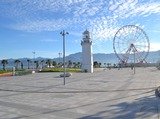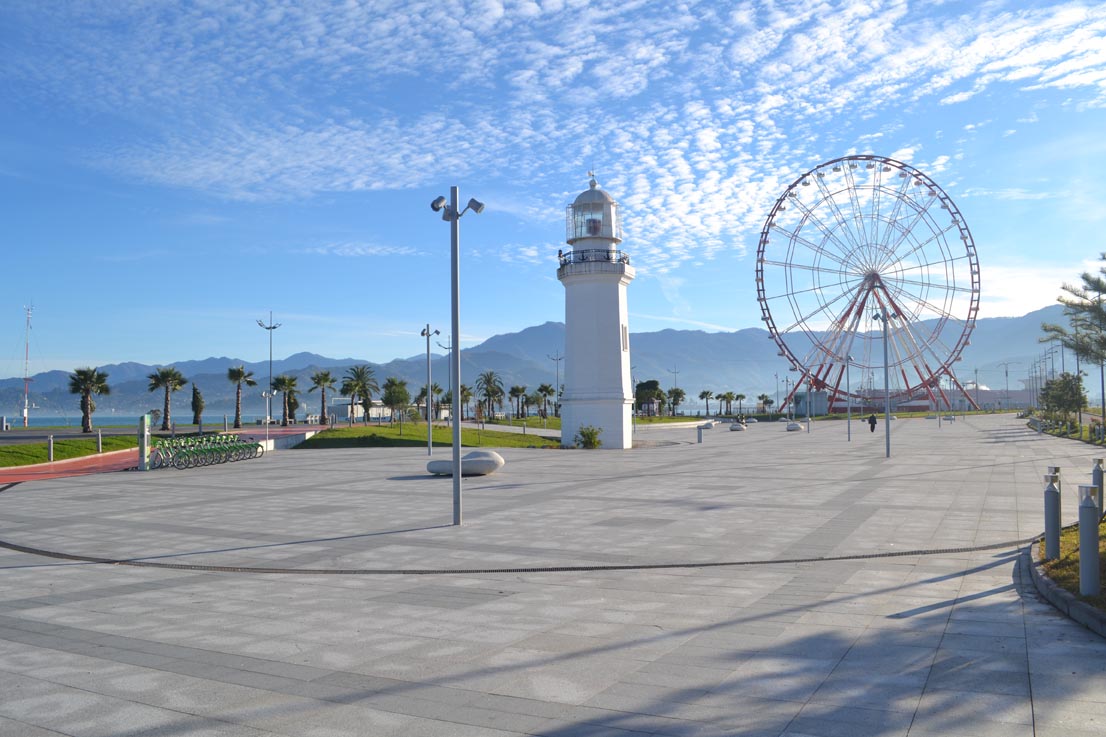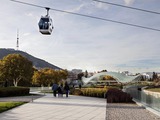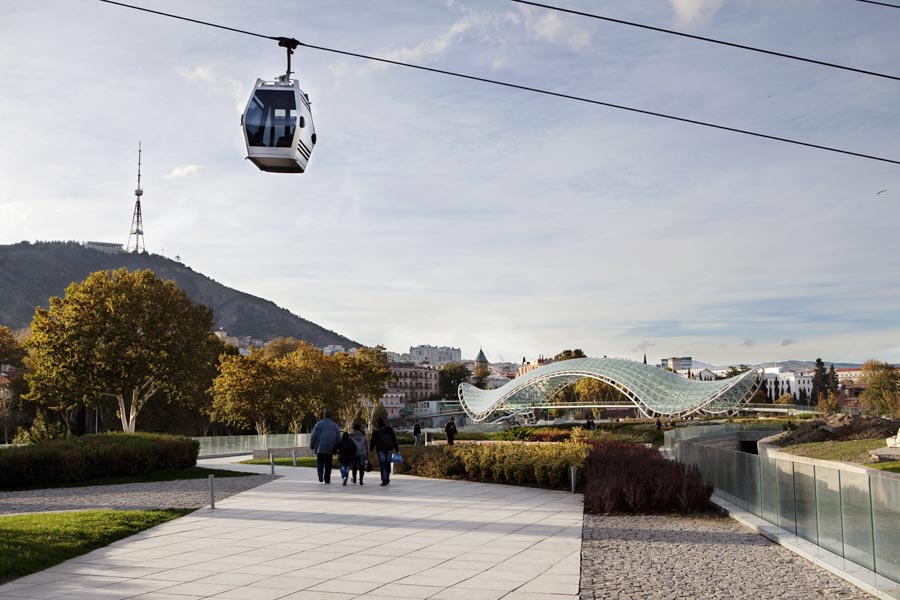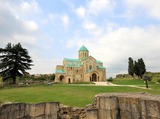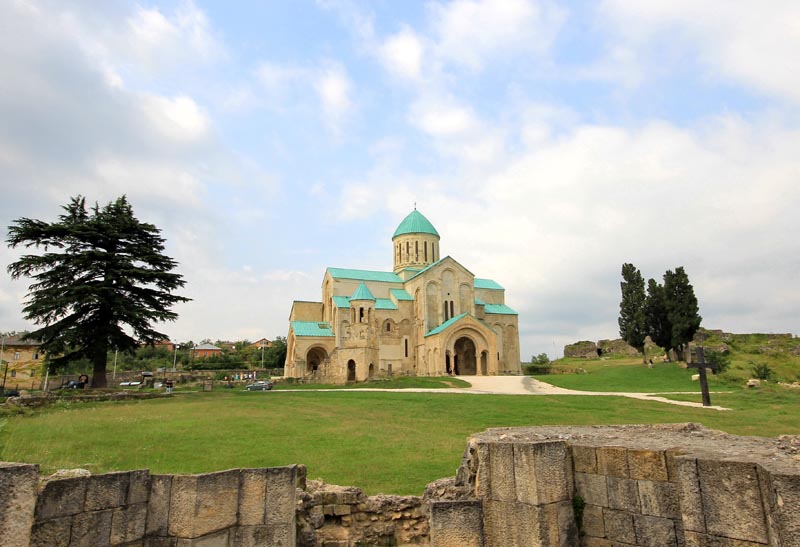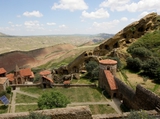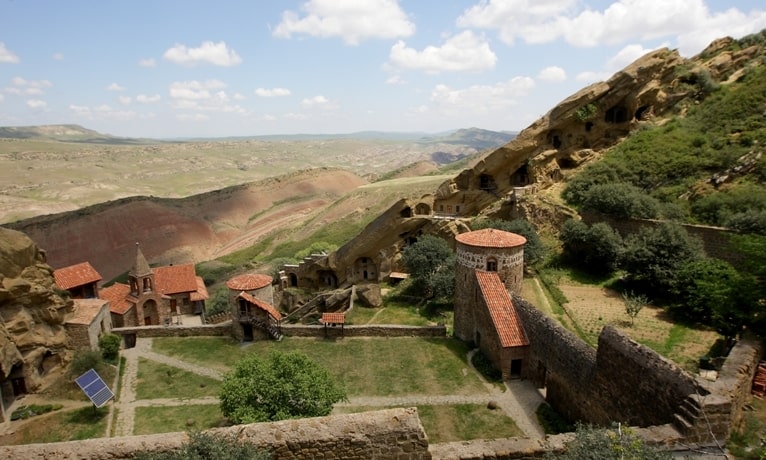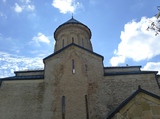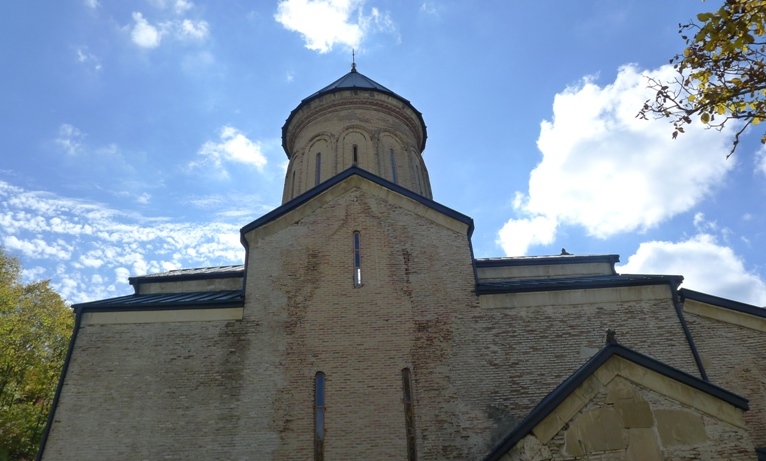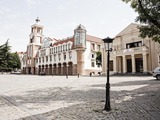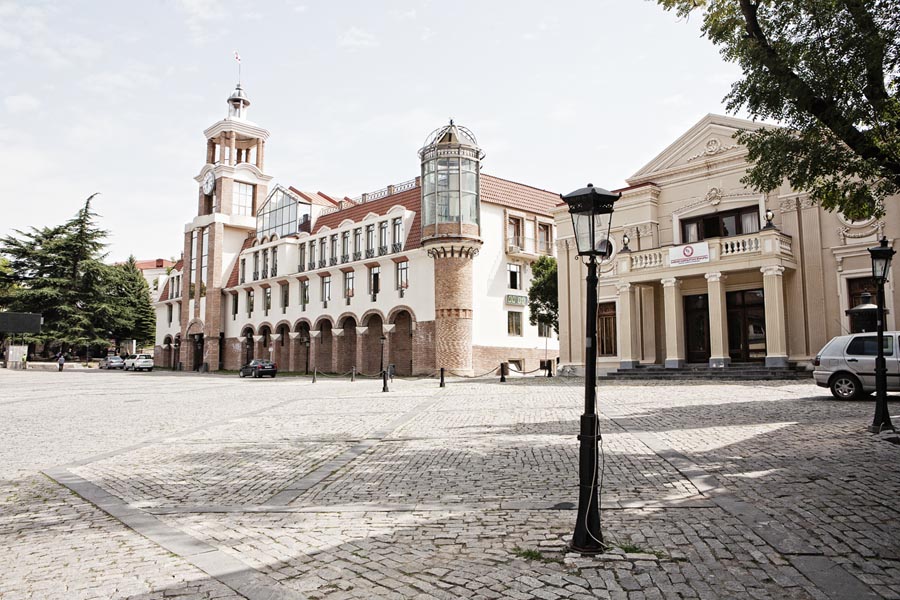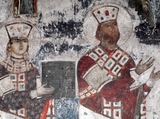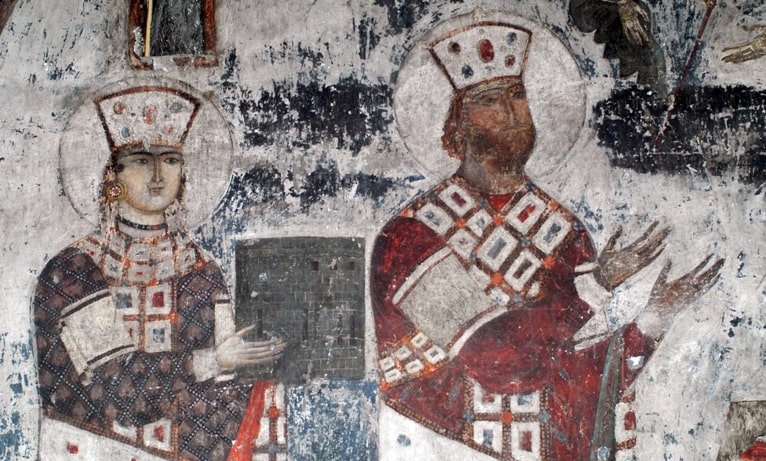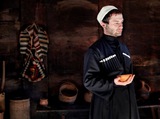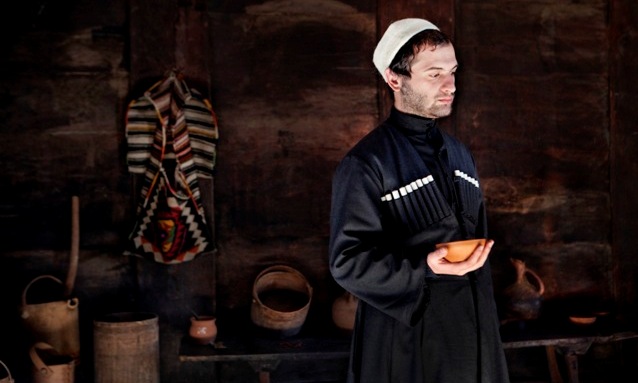Legend has it that God gave Georgians a land that he prepared for himself upon the creation of the world. While science found that ancient ancestors of Europeans lived on this land. It was from here that first people went to populate continents, starting an endless series of human migration on the planet. It was to this land that mythical wealth of Georgia attracted travelers since ancient times. Greek Argonauts sailed to the shores of the mysterious Colchis to get the Golden Fleece. Great conquerors of antiquity led their armies to capture mysterious Iberia. for centuries poets and storytellers of different peoples praised the beauty of this country set amongst magnificent mountains of the Caucasus. And now you have a chance to share the unique culture that Georgia has accumulated over millennia of stormy years. Exotour will show you the great story of the small state in which there are more than 200 museums and about 12 000 monuments from different eras, including those listed as the UNESCO world Heritage sites. Preservation of this heritage has always been associated with a sense of national identity of the Georgian people. Georgians will appreciate your attention to their traditions and they will repay you for this with their phenomenal hospitality. Lets start our journey!
Day 1. Arrival to Georgia
Day 2. Tour: Tbilisi - Mtskheta - Tbilisi
Day 3. Tour: Tbilisi - Signagi - Gurdjaani - Telavi - Tbilisi
Day 4. Tour: Tbilisi - Gori - Uplistsikhe - Kutaisi
Day 5. Tour: Kutaisi - Gonio - Batumi
Day 6. Tour: Batumi - Botanical Garden - Borjomi
Day 7. Tour: Borjomi - Akhaltsikhe - Vardzia - Tbilisi
Day 8. Tour: Tbilisi - Gudauri - Kazbegi - Tbilisi
Day 9. Tour: Tbilisi - Bolnisi - Dmanisi - Tbilisi
10 day. Departure from Georgia
Duration: 10 days / 9 nights;
Length: 2400 km;
Overnight stay: Tbilisi, Kutaisi, Batumi, Borjomi.
Tour itinerary:
Day 1. Arrival to Georgia
Transfer from Tbilisi airport to a hotel. This free eveningcan be used to make the first outing to the streets of the city, to experiment with original dishes of the famous Georgian cuisine and see the nightlife of the capital of Georgia. Undoubtedly, this experience will help you prepare for the next day’s events that will indeed be very exciting…
Day 2. Tour: Tbilisi- Mtskheta- Tbilisi
The capital of Georgia has long been a cultural and political center of the Caucasus. This city counts about 1,600 years since its foundation. Tbilisi’s walls have seen Khazars, Huns, Byzantines, Persians, Mongols, Arabs, Seljuks and Ottomans. Representatives of many nations, of various faiths and civilizations settled in this point of intersection of trade routes, leaving their mark in the image, manners and customs of Tbilisi. Thus was how the unique multicultural character of this city, based on the principles of tolerance and good neighborliness, was created. We will start to perceive this from the historical center.
Abanotubani is a district of sulfur baths. They are built on thermal springs, to which Tbilisi owes its existence. You will learn about the history of the city, hear the legend of the pheasant and King Vakhtang Gorgasali, then climb to the Narikala Citadel. A view from the walls of the ancient fortress offers a splendid panorama of the gorge of the River Mtkvari and picturesque spurs of the Trialeti range, among which Tbilisi is stretched. Then we move to the other side and visit Metekhi – the beautiful church of the XIII century built on a cliff. Here you can take great photos of the Old Town and hear the story of the patron saints of Tbilisi who became martyrs under the walls of this church.
Having crossed the bridge , we will find ourselves on a street named after French traveler Jean Chardin. You will pass by picturesque narrow streets and see the Sioni Cathedral, which was built by one of the greatest kings of Georgia, David the Builder in the beginning of the XII century. From here alleys of the Old Town lead us to Anchiskhati Basilica - the oldest buildingin Tbilisi, which dates back to the VI century and where one of the most esteemed Georgian sacred relic was kept. You will have an opportunity to examine this miraculous icon in precious setting a little later, when viewing the treasures of the Golden Fund and other exhibits of the Museum of Art of Georgia.
Next we have to take a short drive to visit the town of Mtskheta, which was the capital of Georgia before establishment of Tbilisi. Mtskheta is approximately 2,500 years-old and because of the abundance of ancient monuments - which are included in the UNESCO Heritage List – the town is sometimes called Georgian Jerusalem. Here you will see one of the masterpieces of world architecture - Jvari Church built in the end of VI century. The church harmoniously blends into the landscape and still amazes visitors with its perfect architectural forms. From here the beautiful panorama of Mtskheta, which lies between the peaks and the confluence of two rivers opens before our eyes.
Descending from Djvari you will walk through the picturesque streets of old Mtskheta, past shops with souvenirs and local crafts. Our goal lies ahead - majestic cathedral of XI century - Svetitskhoveli. It is the spiritual symbol of Georgia, under which the tunic of Jesus Christ was buried - a piece of clothing, in which the Saviour was clothed at the time of the crucifixion. Here you will hear the legend of Saint Sidonia and the Holy and Life-Giving Pillar, see graves of kings and ancient frescoes, here you will be able to touch the sacred relics of Georgia. This completes the tour of this day. It is time to return to Tbilisi.
Day 3. Tour: Tbilisi - Signagi - Gurdjaani - Telavi - Tbilisi
Georgia is considered the birthplace of wine, and today we are going to most wine-growing region of the country! Kakheti and famous vineyards of the Alazani fertile valley are waiting for us. The first destination of this trip will be the city of love - Signagi. But first, we visit the Episcopal complex of Bodbe. It has a women monastery, original chapel and richly-decorated painted church which dates back to the IX century. Near the altarthere is the tomb of St. Nino, to whom we owe that Christianity became the state religion of Georgia in 327.
In Signagi you often find yourself reminding your own self that you are in Georgia, and not somewhere in Southern Italy. Though, special Georgian flavor of this ancient town will come to help you out of your confusion. It is surrounded by a fortress wall with towers which offers a magnificent view of the Alazani valley and mountains of the Greater Caucasus. While a local museum has exhibition of original paintings of the great Georgian primitivist Niko Pirosmani.
A tripahead is akin to a visit to the wine shop - names of villages will remind you of the famous wine brands of Georgia. Among them hides a wealth of sights to see. One of them can be visit in the district of Gurdjaani. Here, in a wooded valley, stands an interesting monument of the VIII century- church of All Saints with two turrets-domes on the vault. They say that one can not find such unusual basilica nowhere else in the world.
Next stop will be in place where members of the Russian imperial family Romanovs holidayed. The Tsinandali estate is well known for its beauty. Prince Alexander Chavchavadze was a poet and a prominent figure in Georgia. In his home you can find an art gallery and a bar, where you can try Tsinandali - the first Georgian wine produced in accordance with the European technology. The manor is surrounded by a lush garden, where the story of the tragic love of Nino Chavchavadze and the great Russian poet Alexander Griboyedov began.
Alaverdi Cathedral is visible from afar. Built in the early XI century, it majestically shimmers in the middle of the Alazani Valley against the backdrop of the Caucasus Mountains. It is one of four Great Catedrals of the country and the highest of the ancient churches of Georgia. Sense of wonder will not leave you until the monastery of Ikalto where the orthodox Academy functioned in the XII and XVII centuries and where remained the largest in Georgia winepress is still preserved. Experiences of this day will be crowned by seeing the beauty of the convent of Shuamta hidden in the forest and beautiful mountain scenery at sunset on the way to Tbilisi via Gombori pass.
Day 4. Tour: Tbilisi - Gori - Uplistsikhe - Sataplia - Kutaisi
Want to meet one of the most powerful figures of the XX century? A life path of Josef Stalin and his personal belongings will appear before you in a museum in Gori. There are rooms dedicated to childhood, youth and political career of Josef Dzhugashvili. And near the museum there stands a house where revolutionary Koba was born. There you will also see a parked carriage in which Stalin travelled to Tehran and Yalta Conference. All this is overlooked from the mountain top by the Gori fortress walls - one of the largest fortifications in Georgia.
After Gori you are transported to 3000 years back. In the valley of the Mtkvari, on the left bank of the main river of Georgia, stands Uplistsikhe - one of the first cities in the country. It is a city carved in the rock cave history of which starts at the beginning of the Iron Age. Uplistsikhe was a religious center and capital of pagan Georgia. Later it became the scene of fierce fighting between the old beliefs and coming Chrisitanity. This unique city had experienced several ups and downs before people finally abandoned it in the XIX century. Remains of architectural and religious structures built over three millennia are still preserved in Uplistsikhe.
Now we have to cross the Likhi Range to get in western Georgia. You will appreciate the beauty of this mountanous serpentine road, passing through Rikoti pass. By the way, this region is known for its ceramics. Along the way, you can purchase a variety of vessels from handmade ceramic items with traditional Georgian ornaments. They will look great in the living room as a decoration or on the kitchen shelf.
But we have left the winding road behind us and are now in Kutaisi - parliamentary capital and second largest city of Georgia. Here, first of all, we should go and take photos of Bagrati Church. This majestic cathedral listed as a UNESCO World Heritage Site became a new word in the history of the Caucasus architecture at the turn of X-XI centuries. Another World Heritage Site is Gelati Monastery Complex with the grave of the greatest Georgian King David the Builder and the best mosaics in the Caucasus. The XII century academy named by contemporaries as “the second Athens“ functioned in the Gelati Monastery and Neoplatonist monks, along with theology, taught a number of secular sciences there.
Another time travel will take us from the Middle Ages to 70 million years ago. Plateau of dinosaurs in Sataplia reserve has fossilized footprints of different ancient reptiles, including Tyrannosaurus Rex. There are numerous such prints and they are clearly visible. All this is surrounded by relic forest. Try not to be frightened, rubber dinosaurs standing among the trees look just as alive! The path takes us past rocks, dripping with honey from bees living here, and will lead us to the descent of the karst cave. Cold and damp cave is full of beautifully illuminated stalactites and stalagmites, among which you will find a huge stone heart. Once out on the surface, only one thing is left to do – to take a photo of Kutaisi from the observation deck on top of an extinct volcano.
Day 5. Tour: Kutaisi - Gonio - Botanical Garden - Batumi
This day will be spent traveling on the legendary land of Colchis. A highway leads to the Black Sea - the hospitable sea of ancient Greeks. Following its coastline, you will pass several resorts until you reach the main/most important of them. The port city of Batumi is the capital of the Ajara autonomous District and increasingly developing tourist destination. But before we get to know this gem of the eastern Black Sea, we dive into the realm of green Batumi Botanical Gardens.
One of the largest botanical gardens is located on the slopes of Green Cape Mountain and has 9 departments: subtropics of South Caucasus, the Mediterranean, Himalayan forest, thickets of Australia and New Zealand, vegetation of East Asia, as well as of North and South America, including Mexico. There are more than 5000 species and varieties of amazing plants that occupy 113 hectares. The Botanical Garden offers a lovely view of the coastline.
Again we return to antiquity. In the mouth of the River Chorokhi, a few kilometers from the Turkish border, near the village of Gonio stands the fortress Apsaros. Once it was the easternmost outpost of the Roman Empire, and later belonged to the Byzantine Empire. Afterwards it became Genoese trading post until the Ottoman empire took over this fortification. Apsaros was known for its theatre and racecourse. Inside the walls there are remains of Roman baths with ceramic pipes. A modest tomb with a simple iron cross may attract a particular interest – according to one of the versions, apostle - evangelist Matthew is buried here.
Now it is time to explore Batumi. A free evening provides an excellent opportunity to enjoy the charm of the resort town and stock up on some souvenirs. Once settled in a hotel you can walk up to the charming seaside park with a singing fountain. On the boulevard stretched along for 8 kilometers you will find plenty of entertainment as well as a wide choice of restaurants and bungalows. Do not let the distance scare you - everywhere along the beach you can rent comfortable bikes.
Day 6. Tour: Batumi -Borjomi
Of course, one cannot leave Batumi without taking a dip in the sea. So, we allocate the first half of the day to a swim in the warm waves of the Black Sea. Comfortable beach chairs are waiting for you on a pebble beach. While after a sea bath travel to another resort – this time spa resort - awaits us. We will leave Adjarian subtropics and return to continental forests of central regions of Georgia, heading to a small but well-known town of Borjomi. It is famous primarily for its mineral water of volcanic origin.
A Borjomi water source comprises a composition of 60 substances and is known for its healing properties. Borjomi is drank by those suffering from gastrointestinal and renal diseases, as well as problems with metabolism and biliary tract diseases, for treatment of cardiovascular diseases, respiratory and nervous system external use of the mineral water is prescribed. Georgians were aware of the wonderful properties of Borjomi 2000 years ago, having erected stone bathrooms near sources remnants of which have survived to the present day.
Mineral water tasting will be arranged in the Borjomi Park, which is part of the largest nature reserve in Europe. There is a gazebo with a source that comes up from the 8km depth. Nearby you can be photographed against a giant vine. After that you will walk in the park with attractions and history museum located in the former residence of Russian emperors. Lovely view of the Borjomi Gorge from the height of a mountain plateau will be a great end of the day.
Day 7. Tour: Borjomi -Akhaltsikhe - Vardzia- Tbilisi
Today you go to South Georgia - the region of Meskheti, which for centuries has been the scene of continuous wars with Turkish invaders. Nature here is very different from anything you have seen in Georgia so far. Our path runs along the rocky gorges, past battlefields and monuments, passes through the edge of the capital of the region - the city of Akhaltsikhe - and leads to the Saphara monastery. The place for the monastery was chosen so that enemies could not find the shrine. It helped, XIV century-frescoes have been preserved in a very good condition. The churches themselves date back to the X and XIII century. Facades of the large church are decorated with various ornaments and carvings. A religious school operates and several dozen novices permanently reside in this beautiful place.
Khertvisi Fortress, which will become our next stop, was even attacked by soldiers of Alexander the Great. A city with the same name was built here in the IV century BC and is mentioned by chroniclers among the first cities in Georgia. Survived fortifications are significant monuments of the Middle Ages and played an important role in regional geopolitics of the time. This multi-layered architectural complex will be a beautiful addition to your photo album.
A deep rocky canyon leads further. Its walls contain many caves, clearly visible from the windows of our vehicle. These are silent witnesses of centuries of brutal wars: secret passages, hiding places and vaults. You will go past the impregnable Tmogvi fortress that hangs over the left bank of the River Mtkvari as a huge rock. Further, under the edge of the Javakheti plateau you will catch a glimpse of the natural amphitheater of Vaniskvabi cave complex. But this whole series of beautiful views fade into the background as the final point of the trip comes into sight.
Vardzia - an outstanding monument of the Georgian architecture of the XII -XIII centuries - is one of the visiting cards of Georgia. This is a cave monastery complex that originally was a fortress guarding the southern border of Georgia. Its facade stretches nearly 1 kilometer along the steep slope of the Erusheti Mountain. A strong earthquake of 1283 exposed 600 premises: churches, chapels, residential cells, storerooms, baths, refectory, treasuries, libraries. Secret passages linking premises, remnants of plumbing and irrigation system are still preserved. Premises of the complex go to 50 meters deep into the rock and rise to a height of 13 stories.
Examining wonders of Vardzia, you will walk on ancient steps and dive into deep tunnels, marvel at the scale of the project and efforts of constructors of the complex, admire stone carvings and panoramic view of the Mtkvari gorge... You will hear the legend of Queen Tamara the time of reign of whom was the golden age of Georgia and you will see one of her three images in the Church of the Assumption of the Virgin. You will learn about the tragedy of local monks who managed to save the unique frescoes. You will learn about the great Basiani Battle outcome of which determined the fate of Georgia and the entire region for the long time to come. You will leave Vardzia with a sense of admiration for our ancestors and of belonging to the great deeds of the past. A long road back to Tbilisi will contribute to comprehension of the experience of this day.
Day 8. Tour: Tbilisi - Gudauri - Kazbegi - Tbilisi
In the morning, it is time to remember that you have been traveling around Georgia for a week now admiring peaks of the Caucasus Mountains, but had never climbed above the clouds. Today we will correct this unfortunate mistake! You will enjoy the Greater Caucasus and a trip to mountainous Georgia. Our path will run north along the Georgian Military Highway, to the border with Russia. Throughout the route you will be surrounded by dramatic mountain scenery - so do not forget to charge battery of your camera.
You will make your first interesting images on the bank of the Zhinvali reservoir. A vast expanse of water is spread among the forest-covered mountains at the confluence of two rivers - Black and White Aragvi. Eight kilometers from the dam there stands Ananuri castle. The waters of Aragvi rise to the very walls of this magnificent monument of the XVII century. The fortress walls are fortified by two large and several small towers, which offer magnificent views. Inside the fortifications there are two outbuildings and the dome churches, the main church of which is decorated with rich carvings on the facade in the form of a cross and grapes.
Soon the road becomes steeper and starts winding upwards. When ascending to the Cross Pass, we will pass famous ski resort of Gudauri. Forest zone is behind us, and we are surrounded by alpine meadows, with flocks of sheep roaming around. Next the winding serpentine leads to the highest point of the pass. Put some warmer clothes on - over the precipice, at an altitude of 2379 meters, an observation deck is erected which is very convenient for taking pictures of Aragvi Gorge and beautiful panorama of the Greater Caucasus. Meanwhile, you will see clouds float and mountain eagles fly right below.
Just a few kilometers away you can taste sour water with high iron content. This mineral spring flows from the mountain top, and over the centuries has formed a thick layer of richly-colored lime on it. From afar it seems as though the hillside is painted in bright orange colour. From this point begins the descent from the pass to the famous Dariali gorge which, even in antiquity, was called the Gates of the Caucasus. Remember these places - we just crossed the geographical boundary between Asia and Europe, moving from the South to the North Caucasus.
In the hollow of Kobi a highway connects to the river Terek, violent temper of which has repeatedly been described by classics and sung by poets. We will go along the shore and 20 minutes later arrive to Stephantsminda settlement, which was called Kazbegi in the years of 1921-2007. Here they prepare the most delicious khinkali - so do not miss your chance! Moreover, that mountain air stimulates appetite very much and a tasty lunch is a great way to rest before climbing the steep serpentine of the Gergeti Mountain.
One of the symbols of Georgia, church of the Holy Trinity built in the XIV century, with its austere charm and wild beauty of this place have a striking effect on one’s imagination. You will be definitely prompted to think what a titanic work must have done by residents of these places to build a masterpiece of medieval architecture at the height of 2170 meters. However, all thoughts is superseded by a magnificent view of the Dariali Gorge from Gergeti Church. Far below lies Stephantsminda, while on the opposite side of the gorge there is a steep rock wall of height of more than 4 kilometers. There are no enough words to describe the landscape - it must be seen! But the strongest impression you get when you look back.
Gergeti Trinity Church is built against the background of the eternal glaciers of Kazbek - the very same mountains from Greek mythology, where the gods chained Prometheus for stealing fire for people. Its peak whitens at the altitude of 5034 meters, and snow never melts there. Georgian name of Kazbek is Mkinvartsveri, which means icy peak. This mountain is surrounded with lots of ancient stories and legends. A variation of the legend of Prometheus is in the folklore of all peoples living in the shadow of Mount Kazbek - Georgians, the Ingush, Chechens and Ossetians.
Try to leave a little space in a memory card of your camera - our journey is not over yet. Descending from Gergeti, you go to the picturesque mountain village of Sno and see the old houses of Georgian mountaineers. Local landmark - a beautiful little fortress with a typical mountainous tower is perfect for group photo in the memory of the journey to the peaks of the Caucasus. Now the program of the day is concluded and we can return to Tbilisi.
Day 9. Tour: Tbilisi - Bolnisi - Dmanisi- Tbilisi
Did you know that the Georgian alphabet is one of the 14 original alphabets created by the humanity? The legend tells of origination of the Georgian writing in the III century BC, scientists argue about different theories of a later period. Some of the most ancient Georgian inscriptions are found on the walls of the Bolnisi Sioni Church. This church itself is the oldest basilica in the country and with it the history of the Georgian church architecture began.
Bolnisi Sioni Church was built in 478-493 years, immediately after gaining autocephaly by the Georgian Orthodox Church. When arriving to the church you will find that in that early days architects did not seek to decorate facades. Emphasis was on the interior. Thus, exterior of the church is decorated with only lining of green tuff. While inside of the church produces monumental impression of strength and greatness thanks to its simple forms and harmonious proportions.
Another leap into the past awaits us ahead in the town of Dmanisi. Discoveries that were made here caused a sensation in the world of anthropology. During an excavation, scientists found five well-preserved remains of primitive people. Analysis showed that age of Homo Georgicus is 1.77 million years - that is, it is the most ancient man who lived on the territory of Europe. Learning more about our distant ancestors is possible in the museum, which operates in Dmanisi archaeological zone.
Among the other attractions of this place are remains of the city that emerged in the VI century - remains of walls and towers, VII century basilica and well preserved baths. Around the deserted Dmanisi settlement lie beautiful mountains and canyons, and atmosphere of antiquity flows in the air. Having finished the tour, we can return to Tbilisi. The last evening in the capital of Georgia can be dedicated to a farewell supper or to a visit to the sulfur baths, where a bathhouse attendant – so-called Mekise and a nice massage await you.
10 day. Departure from Georgia
Unfortunately, today you leave Georgia. It is time to pack up all the souvenirs and say goodbye. We will take you to the airport confident of a future meeting. After all this tour has not exhausted all that Georgians are ready to offer. And you will surely return to get to know the country that lies among the Caucasian mountains, as well as its people, better.


